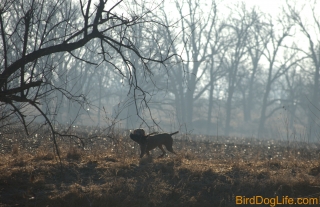It’s starting to get pretty warm out there. You’ve had plenty of time to let the fond memories of the past season sink in. Take a moment and think back one more time of those crisp mornings and great bird work pup put in. Ok, so maybe it wasn’t ALL great. You know what I’m talking about; a creep and a busted bird here, a repeated command or two there. Most of us tend to let things slip with our dogs during the “regular season” in an effort to be as productive and enjoy the time in the great outdoors as much as possible. I admit it, my boy Bo got sloppy from time to time as much as anyone else!
However, instead of dwelling on those not so fond memories it’s time to do what your old school teachers would do to you if you slacked off all winter long in class. SUMMER SCHOOL.
That’s right… It might be getting pretty warm outside but what better time to be out working with your pup when you can be comfortable! Personally I like to go back to basics in the early summer. We start with a refresher and go back to yard work. We’ll cover all the basic commands again to remind pup who is in charge and to keep the working relationship between you strong. I know… your dog is perfect on all of this stuff already. I’m convinced that you can never add enough polish to a well performing dog. While you’re doing the remedial yard work take some time and come up with a list of things you know got loose last season. Come up with a plan to tighten those things up. When you complete your routine training it’s time to execute your plan to get pup ready for fall. The key here is to start early and to continue making progress just like when you were initially starting your new hunting prospect out!
Tips for summer season training:
- Train early or late in the day. Summer heat is far tougher on your four-legged friend than it is on you.
- Take every opportunity to ensure that your dog is properly hydrated. Even if he is not thirsty they need to consume water in hot weather. A dog’s reflex to drink is not triggered until they are already past 60% of the way to dangerous dehydration.
- Break your training up into short sessions, no more than 15-20 minutes at a time. More short sessions is better for your pup than one long one. Not only does it keep them cooler it helps them to absorb your lessons.
- Combining training sessions with conditioning sessions early or late in the day can help to keep your pup from becoming a couch potato and needing to go to boot camp to get in shape for the fall.
- Try to avoid letting your dog drink from ponds and streams. A lot of us do this and a majority of the time it causes no trouble. But bear in mind that just because a stream looks crystal clear doesn’t mean it isn’t teaming with microbial pathogens that will send your poor hunting buddy’s digestive tract for a loop or could potentially kill them.
- Take a few steps back from the specific lesson you feel your pup needs refreshing on. Start from the beginning to help the pup remember exactly what is expected of him.
- Change things up! Dogs get just as bored as we do with a routine. Don’t beat the same drills into the dog day after day. Come up with a training plan that not only encompasses what you want to accomplish for the day but one that will help guide you to a longer term goal.
At the end of the day it’s important to remember that this is supposed to be fun for all of us; the dogs included. Do what you can to help your dog perform to your expectations in the fall so you can both enjoy the time instead of getting an ear ache from the whistle!


Leave a Reply